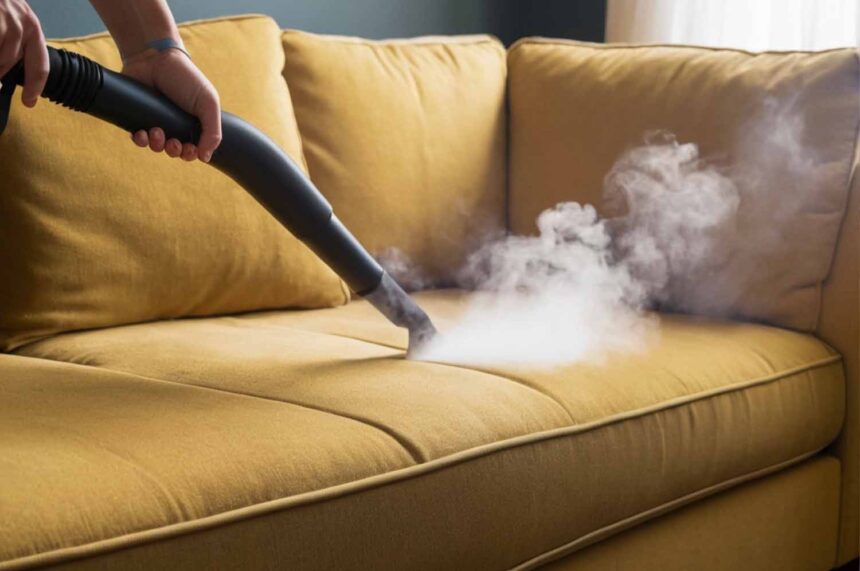Growing up, we used to jump right onto the couch after a long, hot day of playing outside(we were gross boys). My mom was always livid at the baked-in funk in the couch!
A couch may emit an odor due to residual moisture, which can activate pre-existing smells or cause mildew. Proper ventilation and drying are crucial to prevent this and ensure the couch returns to a neutral smell.
Below are all the techniques my mom used to beat the couch funk, plus a few I picked up on my own.
Warning: Getting the smell out of the couch takes work. Depending on the severity will determine how much elbow grease will be involved. Proceed only if you’re serious about getting the smell out of your couch.
Deep Cleaning Strategies for Refreshing Your Couch
After steam cleaning, it’s especially essential to use targeted strategies to ensure that your couch doesn’t just look clean but feels and smells fresh too. Let’s explore effective deep-cleaning techniques tailored for different upholstery types.
Choosing the Right Upholstery Cleaner
When it comes to deep cleaning a couch, the choice of upholstery cleaner can make a significant difference. For leather couches, I often recommend a dedicated leather cleaner that’s designed to hydrate and protect while cleaning. It’s imperative to avoid any cleaners that may contain harsh chemicals capable of stripping the leather’s natural oils.
For a fabric couch, including those made from microfiber, the approach is a bit different. A mild detergent or a cleaner specific to the fabric’s care label is my go-to.
Steam cleaning can be beneficial for these types of upholstery, but following up with the right cleaner ensures that no residue or trapped odors remain.
The Role of Enzyme Cleaners in Odor Elimination
If dealing with persistent smells, incorporating an enzyme cleaner could be a game-changer. The enzymes in these cleaners break down the organic matter causing the odor, effectively neutralizing it.
This is particularly useful for couches that have absorbed pet smells or have been stained by spills that have gone beyond the surface.
I find that enzyme cleaners work well across different types of materials, but it’s still crucial to test them on a small inconspicuous area first.
Whether a couch is leather, microfiber, or another fabric, enzyme cleaners used correctly can drastically reduce or even eliminate odors, making them a valuable tool in my deep clean arsenal.
Understanding Couch Odors Post-Steam Cleaning
After a steam cleaning session, a couch should ideally smell fresh and clean. However, sometimes odors persist, and understanding why can help prevent them in the future.
The Science of Odor Persistence
Odors are volatile compounds that emanate from a source, and in the case of a couch, they can come from bacteria or mildew that wasn’t completely eradicated during cleaning.
Typical steam cleaning involves hot water vapor which can reach into the couch’s fibers to clean but may not always reach all the odor-causing particles or may contribute to a moist environment where odors can thrive.
This can happen especially if the cleaners used did not have antibacterial properties or were improperly applied.
Common Mistakes Leading to Smelly Couches
Several missteps might lead to a smelly couch post-cleaning:
- Insufficient Drying: Not allowing the couch to dry completely can facilitate mildew growth, a common culprit behind musty odors.
- Overlooked Spots: Missing areas during steam cleaning means leaving behind bacteria and dirt, which can cause unpleasant smells to persist.
- Using the Wrong Cleaners: Some cleaners might mask rather than neutralize odors, or even leave behind residues contributing to a cycle of odor recurrence.
- Not removing foam: If you own a couch where you can unzip cushions and remove the foam, then you are in luck. This can improve the effectiveness of your couch cleaning. Put your couch cushion bags in the wash and let the inner foam dry in the sun.
By addressing these issues, You can enhance the effectiveness of steam cleaning and maintain a fresher-smelling couch.
Daily Maintenance to Prevent Odors
In my experience, keeping a couch smelling fresh requires regular care. Here, I’ll share my thorough yet straightforward strategies for daily maintenance to nip odor issues in the bud.
Proper Vacuuming Techniques
Vacuuming isn’t just for floors; it’s essential for couches too. I make it a point to regularly vacuum my couch, focusing on every crevice where crumbs and pet hair can hide. For the best results, I use:
- A crevice attachment to reach deep into the folds.
- An upholstery brush for general surface work, being gentle on fabric and microfiber.
- If it’s a leather couch, a soft brush attachment prevents scratches.
Spot Cleaning Spills and Stains
Prompt attention to spills can prevent permanent stains and lingering odors. Here’s my approach:
- Blot (don’t rub) liquid spills immediately with a clean cloth.
- For tougher stains, I use a mild solution suitable for the material:
- Fabric or microfiber: A mix of dish soap and water does the trick.
- Leather: A damp cloth with mild soap, followed by leather conditioner, keeps it clean and supple.
Regularly addressing cushions by removing them for separate cleaning ensures no odors seep into the fabric. This proactive mindset helps me maintain a fresh couch free of unwanted smells.
Home Remedies for Deodorizing Your Sofa
When my sofa starts to smell a little off after steam cleaning, I turn to a couple of tried-and-true home remedies. These methods are not only effective at eliminating odors but are also safe for most types of upholstery.
Natural Solutions with Baking Soda and Vinegar
Baking Soda: I often start by generously sprinkling baking soda over the entire surface of the couch, making sure to get into all the nooks and crannies. Baking soda is excellent for absorbing odors, and it doesn’t harm the fabric.
I let it sit for at least 15 minutes – though, for stronger smells, leaving it overnight is preferable. Afterward, I vacuum it up using an upholstery attachment to remove all traces of the powder.
Vinegar: A mixture of equal parts water and white vinegar – particularly distilled white vinegar, due to its deodorizing properties – can be used to create an effective cleaning solution.
I spray this lightly over the sofa surface, being cautious not to saturate it. The vinegar smell dissipates as it dries, taking the unwanted odors along with it.
Using Essential Oils for a Fresh Scent
With the cleaning power of vinegar and baking soda, sometimes a boost of freshness is all that’s needed. That’s where essential oils come into play.
I select my favorite scent – typically lavender or lemon for their clean, invigorating properties – and add a few drops to a spray bottle filled with water.
A gentle mist over the couch not only imparts a pleasant smell but also helps to maintain a fresh environment. Essential oils are a natural alternative to synthetic fragrances and can be customized to suit my scent preferences.
Advanced Tips for Keeping Your Couch Smell-Free

Ensuring your couch remains smell-free involves targeted strategies to combat pet odors and mold growth, which are common issues in many households. I’ll walk you through some sophisticated methods that go beyond simple cleaning.
Managing Pet-Related Odors
I understand that pets can leave behind odors that embed in the fabric of your couch. The key here is to neutralize these smells without harming your pets.
Activated charcoal is a highly effective odor absorber that I use for this purpose. It naturally eliminates odors without releasing any harmful chemicals.
I suggest placing activated charcoal packets under the cushions or in strategic areas around the couch to continuously deodorize the space.
In addition to that, it’s crucial to address the odor-causing bacteria and dander that pets leave behind. Frequent vacuuming using HEPA filters can help remove these allergens from your couch. Also, consider using enzyme-based cleaners specifically designed to break down the proteins in pet urine, saliva, and dander that contribute to bad smells.
Preventing Mold and Mildew Growth
Mold and mildew are often the culprits of a musty-smelling couch, especially after steam cleaning when the fabric may remain damp for a time.
To prevent this, I make sure the couch is completely dry after any cleaning process. If possible, I expose it to sunlight, which not only aids in drying but also acts as a natural disinfectant.
A dehumidifier can also be an excellent tool to maintain a low-humidity environment, making it less hospitable for mold and mildew to grow.
Additionally, I sometimes apply a solution of white vinegar and water to the couch’s surface.
This mixture should be lightly sprayed and then wiped down, as vinegar is known for its ability to kill mold and mildew spores, neutralizing potential smells before they start. Remember, always do a spot test in an inconspicuous area first to ensure the fabric reacts well to the vinegar.








